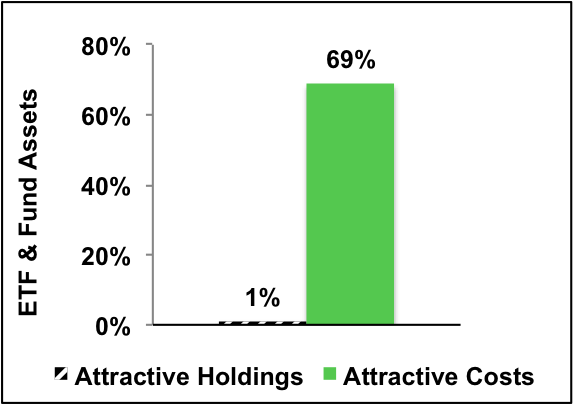Fund holdings affect fund performance more than fees or past performance. A cheap fund is not necessarily a good fund. A fund that has done well in the past is not likely to do well in the future (e.g. 5-star kiss of death and active management has long history of underperformance). Yet, traditional fund research focuses only on low fees and past performance.
Figure 1 shows that 69% of fund assets are in ETFs and mutual funds with low costs but only 1% of assets are in ETFs and mutual funds with Attractive holdings. This discrepancy is astounding.
Figure 1: Allocation of Fund Assets By Holdings Quality and By Costs

Sources: New Constructs, LLC and company filings
Two key shortcomings in the ETF and mutual fund industry cause this large discrepancy:
- A lack of research into the quality of holdings.
- Not enough research focuses on the quality of portfolio management of funds
- A lack of high-quality holdings or good stocks.
- With about twice as many funds as stocks in the market, there simply are not enough good stocks to fill all the funds.
These shortcomings are related. If investors had more insight into the quality of funds’ holdings, I think they would allocate a lot less money to funds with poor quality holdings. Many funds would cease to exist.
Investors deserve research on the quality of stocks held by ETFs and mutual funds.
Quality of holdings is the single most important factor in determining an ETF or mutual fund’s future performance. No matter how low the costs, if the ETF or mutual fund holds bad stocks, performance will be poor. Costs are easier to find but research on the quality of holdings is almost non-existent.
Figure 2 shows investors are not putting enough money into ETFs and mutual funds with high-quality holdings. Only 94 out of 6706 (1% of assets) ETFs and mutual funds allocate a significant amount of value to quality holdings. 99% of assets are in funds that do not justify their costs and over charge investors for poor portfolio management.
Figure 2: Distribution of ETFs and Mutual Funds (Count and Assets) By Portfolio Management Rating

Source: New Constructs, LLC and company filings
Figure 3 shows that investors successfully find low-cost funds. 69% of assets are held in ETFs and mutual funds that have Attractive-or-better rated total annual costs, our apples-to-apples measure of the all-in cost of investing in any given fund.
Out of the 6706 ETFs and mutual funds we cover, 1524 (69% of assets) earn an Attractive-or-better Total Annual Costs rating.
Clearly, ETF and mutual fund investors are smart shoppers when it comes to finding cheap investments. But cheap is not necessarily good.
PowerShares S&P SmallCap Utilities Portfolio ETF (O:PSCU) gets an overall predictive rating of Very Dangerous because no matter how low its fees (0.32%), we expect it to underperform because it holds too many Dangerous-or-worse rated stocks. Low fees cannot boost fund performance. Only good stocks can boost performance.
Figure 3: Distribution of ETFs and Mutual Funds (Count and Assets) By Total Annual Costs Ratings

Source: New Constructs, LLC and company filings
Investors should allocate their capital to funds with both high-quality holdings and low costs because those are the funds that offer investors the best performance potential.
But they do not. Not even close.
Figure 4 shows that less than half (49%) of ETF and mutual fund assets are allocated to funds with low costs and high-quality holdings according to our Predictive Fund Ratings, which are based on the quality of holdings and the all-in costs to investors.
Figure 4: Distribution of ETFs and Mutual Funds (Count and Assets) By Predictive Ratings

Source: New Constructs, LLC and company filings
Investors deserve forward-looking ETF and mutual fund research that assesses both costs and quality of holdings. For example, PowerShares KBW Property & Casualty Insurance Portfolio ETF (N:KBWP) has both low costs and quality holdings.
Why is the most popular fund rating system based on backward-looking past performance?
We do not know, but we do know that the transparency into the quality of portfolio management provides cover for the ETF and mutual fund industry to continue to over charge investors for poor portfolio management. How else could they get away with selling so many Dangerous-or-worse rated ETFs and mutual funds?
John Bogle is correct — investors should not pay high fees for active portfolio management. His index funds have provided investors with many low-cost alternatives to actively managed funds.
However, by focusing entirely on costs, he overlooks the primary driver of fund performance: the stocks held by funds. Investors also need to beware certain Index Label Myths.
Research on the quality of portfolio management of funds empowers investors to make better investment decisions. Investors should no longer pay for poor portfolio management.
Disclosure: David Trainer and Blaine Skaggs receive no compensation to write about any specific stock, sector or theme.
